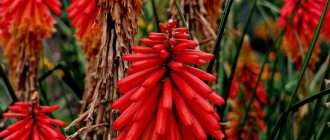Description and photo
All varieties of the Lilipot series are dwarf (not higher than 25 cm). They grow in the form of a bush and are characterized by intensive stem formation. The carnation is compact and does not require pinching of the tops in the initial stage of development.
The growing season of the plant lasts for five months. The varieties bloom after sowing seeds in February in June; in open ground the cycle lasts until October. In greenhouses, the Lilipot carnation can bloom throughout the year.
External characteristics of clove habit:
- the stems are erect, very densely spaced, light green, can have single buds or branch at the crown into 2–3 short peduncles;
- the leaves are narrow, elongated, with pointed tips and smooth edges. The main concentration is observed at the base of the bush. They are smaller along the stem, sessile, alternate, dark green with a blue tint;
- the root system is taprooted, deepened by 20–30 cm;
- The flowers are double, with rounded petals and finely toothed edges. Their diameter is 6 cm.
Important! Lillipot cloves have a distinct spicy aroma. This factor is taken into account when growing crops indoors.
Frost resistance
The frost resistance of the Lillipot series is average; it can winter without shelter in a climate zone where temperatures do not drop below -10 C. In gardens they are grown only in open areas; carnations are heat-loving with good drought resistance. Carnation Lilipot tolerates short-term water deficits better than constant waterlogging of the soil. The soil for planting must be fertile and slightly acidic.
How it blooms
There are several varieties of Lilipot carnations, which differ in the color of the inflorescences. Seeds of both individual varieties and mixtures are available for sale.
The main varieties of Lilipot carnations:
- white;
- lavender pink;
- light lilac;
- scarlet;
- orange;
- lilac;
- yellow.
Carnation produces large double flowers with a diameter of up to 6 cm. Flowering lasts continuously throughout the summer. By eliminating fading inflorescences, the formation of new buds is stimulated.
The growing season of the plant ranges from 16 to 20 weeks. The flower is grown as an annual or biennial plant. Inflorescences form 5-6 months after seed germination.
Garden carnation Lilipot - perennial or annual plant
According to its biological characteristics, the Lilipot variety is a perennial crop. The life cycle of the plant is 5 years. In the open ground of the subtropical zone and indoors, cloves are grown until they age.
Important! The only representative of dwarf varieties that can be grown as a perennial in all climatic zones is the Lilipot Purple F1 carnation. It is frost-resistant down to -24 C.
History of selection
A hybrid variety of the Lillipot culture was created on the basis of the Japanese company Sakata. The variety is based on wild Chinese carnation. The corporation is the copyright holder and supplier of seeds worldwide. The Lillipot series is a genetically dwarf form that does not require correction of growth in height and width, adapted to sudden changes in weather. The group includes varieties with various colors of large double flowers. Carnation Lillipot is recommended for growing in open ground, flower pots, and greenhouses.
Briefly about the main thing:
- Perennial.
- A series of genetically dwarf carnations.
- Height 25 cm.
- Forms numerous flowers all summer.
- Remains short and compact without pinching or the use of growth regulators.
A colorful plant for gardens and patios, containers and flowerpots. Can be grown as a potted crop (pot diameter 10-15 cm).
Description of carnation Lillipot
Carnation Lillipot is a perennial hybrid of Japanese selection. This is a whole series that consists of several dwarf varieties. The height of such carnations does not exceed 25 cm, but the bushes branch well. Its peculiarity is that its compact size is due to genetics, and there is no need to pinch the shoots. Different varieties have their own colors. The most popular colors of Lilipot carnations:
- white;
- yellow;
- orange;
- purple;
- pink lavender shade;
- lilac.
Carnation Lilipot is a perennial plant in warm climates or grown as an annual in regions with cold winters. The flowers are quite large in size, double in structure, reaching a size of 5-6 cm. Buds are formed throughout the season.
Garden carnation Lillipot in the photo:
Advice! For the active formation of new flowers, dried flowers must be promptly removed from the carnation.
The crop is often grown as a biennial. The growing season averages 17-20 weeks. Carnation Lilipot is suitable for flower beds and also does well at home. This is a fairly common flower due to its high decorative qualities. In landscape design, it is used to decorate borders; Lilipot carnations are often planted along walls, fences or paths.
Landing
Seeds are planted from January to April to ensure flowering of the bush in the summer. To force plants by the beginning of spring, seeds are planted in July-August.
- Boxes intended for growing seedlings are filled with soil. The soil is compacted and moistened with warm water from a spray bottle.
- It is convenient to plant seeds in cassettes measuring 2x2 cm. Then the seedlings do not require picking.
- Clove seeds are stored in the refrigerator. A day before planting, they are transferred to a warm place.
- Planting material is placed on the soil surface in increments of 2 cm. When using cassettes, one seed is placed in each cell.
- Carnation Lillipot germinates in good light. Therefore, the seeds are pressed into the soil or a thin layer of earth is poured on top.
The plantings are covered with plastic film. Turn it over periodically to remove condensation. Seed germination occurs at temperatures from +18 to +20 °C. The first shoots will appear in a week.
When to plant in the ground
In May-June, the Lillipot carnation is transferred to an open area. The plant prefers lighted places and light fertile soil. Carnations are planted on rocky and sandy soils. The flower actively develops next to stones that heat up in the sun.
In order for the plants to quickly adapt to natural conditions, they are hardened off in the fresh air 3 weeks before planting. In a room with plantings, open a window or move the boxes to the balcony.
Procedure for transplanting Lillipot carnations:
- Preparation of planting holes in increments of 10-15 cm.
- Abundant watering of plants.
- Transferring cloves without destroying the earthen clod and burying it.
- Covering the roots with soil and watering them abundantly.
For transplantation, choose the morning or evening period; during the day, work is carried out in cloudy weather. It is not recommended to bury seedlings, otherwise the plant will begin to hurt and may die.
Growing from seeds
Lilipot carnation can be grown all year round. It is suitable for a balcony, garden plot and is in demand in the flower market. The most common practice is to grow Lilipot purpurea from seeds.
Soil preparation and planting scheme
Lillipot carnations are sown from January to April. This period is chosen so that the bushes will already bloom in the summer. If it is necessary to ensure the appearance of buds in the spring, then planting Lilipot carnations with seeds should be done in early August.
For successful cultivation it is necessary to provide slightly acidic soil. This can be soil from the site or purchased from a specialty store. In the first case, the ground must be disinfected.
Boxes prepared for seedlings are filled with soil, compacted and sprayed with warm water from a sprayer. You can use special 2*2 cm cassettes for planting seeds. This will allow you to avoid planting seedlings in the future. Clove seeds are kept in the refrigerator, and the day before planting they must be transferred to a warm place. In the ground, sowing is done in 2 cm increments. In the case of cassettes, seeds are placed in one cell. The plantings are covered with film and put away in a dark room.
Seedling care
When the shoots appear, the cover is removed from the boxes. The seedlings should be in partial shade during this period. The room temperature should be reduced to + 15 °C. Next, the Lilipot carnation needs the following care:
- ventilation on a regular basis;
- watering with water at room temperature;
- when two leaves appear, the seedlings should be fed with calcium nitrate (1 g per 1 l);
- lighting for at least 14 hours using special lamps.
Advice! To make the Lillipot carnation bush more compact and more branched, young seedlings are pinched above the second pair of leaves. If desired, you can root the top and get another plant.
After 1.5 months, the seedlings are placed in a container with a side height of about 10 cm. The substrate is prepared from peat, soil, sand and humus. After 10 days, it is necessary to fertilize with potassium nitrate (15 g per 10 l).
3 weeks before planting in the ground, the bushes are hardened in air. To do this, open the window or move the boxes onto the balcony.
Planting in open ground
The time for planting Lilipot carnations in open ground is the end of May-June. For the flower, choose a sunny area with light soil. Rocky and sandy soil works well. The algorithm for transplanting Lillipot carnations looks like this:
- Preparing holes in 15 cm increments.
- Abundant watering of the soil.
- Transferring seedlings while preserving the earthen ball.
- Sprinkling soil on the roots.
- Watering.
Replant the cloves in the morning or evening. If you need to do this during the day, then only in cloudy weather; you should not allow the weakened plants to be exposed to sunlight. Seedlings cannot be buried.
Reproduction
Cloves are propagated vegetatively and generatively. The structure of the root system does not allow dividing the mother bush into parts; if you try, the old plant may die and the plot may not take root. You can propagate the perennial carnation Lillipot by layering, but the method is not very effective, because the material obtained is small and it does not take root well after cutting. Cuttings are used more often.
Important! The optimal reproduction option is generative.
Propagation of Lilipot carnation by seeds
The Lilipot variety is grown by seedlings or by sowing seeds in the ground. The second option is only possible in warm climates. Preliminary receipt of planting material will speed up the budding time and eliminate the possibility of seedlings being damaged by return frosts.
In the subtropical climate of the south, seeds are sown in open ground at the end of March, when the temperature reaches +8 C. In July, the crop will bloom. Garden carnation Lilipot Purple is an early flowering variety, therefore it is recommended to grow it only from purchased seeds in seedlings. The hybrid does not produce complete material; the flowers are sterile.
When propagated by seeds, Lillipot carnations are planted in slightly acidic soil. The soil chosen is light, peaty, and weakly acidic. It is recommended to take soil from a garden plot or purchase ready-made flower soil.
Propagation of Lilipot carnation by cuttings
Cuttings are prepared from the first stems whose inflorescences have dried. Select an area with three vegetative buds. They cut at an angle, in the lower part a vertical cut with a depth of 0.5 cm is made in the center. In warm climates, Lilipot carnation cuttings are placed in fertile substrate on the site and a mini-greenhouse is installed. The structure is covered for the winter, and in the spring the rooted material is planted in a designated area.
Advice! Before placing the cuttings in the soil, cut off the lower leaves, leaving 2 at the top.
In cold climates, plant in a container with a nutrient mixture, cover with film, and constantly ventilate. For the winter they are brought indoors. Cuttings of Lilipot carnations are rarely practiced; this method is more labor-intensive and less effective than sowing seeds.
Planting garden carnations, care and propagation
All garden carnations are afraid of damping off in winter, so they require well-drained soil. Low-growing species look best on alpine hills or rockeries. Amur (D. amurensis), sandy (D. arenarius), and stone (D. petraeus) grow well there.
In flower beds in the foreground you can plant Turkish, Alpine, grass and pinnate carnations. They go with almost all colors.
All types of carnations love sunny, well-ventilated places with light soil. G. fluffy prefers slightly acidic soils, while other species grow well in neutral ones.
All types of garden cloves absolutely cannot tolerate stagnant water, especially in spring.
Caring for these flowers is easy. They require pruning of faded inflorescences and stems and weeding, since curtains cannot compete with weeds.
All species reproduce well by seeds. Turkish and pinnate cloves can be propagated by layering.
Perennial sods are divided; this can be done during flowering. Small divisions with two or three stems take root better. Large bunches often rot. Delenki are planted for growing in a sand-peat mixture.
Seedling care
After emergence of seedlings, the film is removed, and young plants are provided with partial shade. To prevent seedlings from stretching, the temperature is lowered to +15 °C.
When propagated by seeds, the Lilipot carnation is provided with certain care:
- regular ventilation;
- watering with warm water;
- feeding when 2 leaves appear with a solution of calcium nitrate in the amount of 1 g per 1 liter of water;
- continuous lighting for 14-18 hours.
To get a branched and compact bush, seedlings are pinched above the second pair of leaves. The top can be rooted to produce another plant.
After 6-7 weeks, the plants are transplanted into containers 9-10 cm high. The substrate is obtained from peat, light soil, humus and river sand in a ratio of 3:1:1:1. After 10 days, the plants are fed with potassium nitrate. For 10 liters of water, take 15 g of fertilizer.
Watering
Carnations are watered moderately when the top layer of soil dries out; during drought, plants require more moisture. For irrigation, take warm, settled water and apply it at the root. Watering is left in the morning or evening hours, when there is no direct sunlight.
After adding moisture, the soil is loosened to ensure oxygen access to the roots. After loosening, the absorption of moisture and nutrients by cloves improves.
Top dressing
Regular feeding helps stimulate the formation of new shoots. For processing, take complex flower fertilizer and dilute it with water. Cloves are watered with a nutrient solution every 10 days.
Cuttings of carnation Lillipot
In order not to lose the varietal characteristics of the plant, cuttings are carried out. The shoots are cut off in early June. You need to choose a stem about 10 cm long with 3 nodes. It is separated by removing the lower pair of leaves. The cuttings are cut and placed in moist soil. Shoots germinate best in a greenhouse. The formation of roots occurs after 3 weeks and then planting in a permanent place is possible.
Carnation Lilipot is also successfully propagated by dividing the bush. They dig it up, then use a sharp and clean knife to divide it into 2-3 parts. The resulting bushes are freed from inflorescences and shoots. The cloves are placed in a permanent place and watered abundantly.
Wintering in different regions
When grown as an annual in the fall, the cloves are dug up along with the roots when the last inflorescences wither. It is recommended to burn the plant to prevent the spread of diseases and pests.
The flower tolerates cold temperatures down to -10 °C. Under snow cover, the plant can withstand frosts down to -27 °C.
When grown in warm climates, it is left without shelter. Before wintering, dry shoots and inflorescences of the Lilipot carnation are cut off.
Advice! In cold climates, it is recommended to cover the bushes with dry leaves, spruce branches or agrofibre.
Another option for overwintering Lilipot carnations is to dig up a bush and plant it in a pot. The shoots are pruned and the flower is kept at home. In winter, the intensity of watering is reduced and fertilizing is not performed. In spring, carnations are transferred to open ground.
Advantages and disadvantages
The Lilipot series is the most popular of the short-growing representatives of the culture. It has earned its popularity due to a number of qualities:
- the flowers are large, double, with a pleasant aroma and all kinds of colors;
- long and continuous flowering period;
- the bush is compact, dense, does not require correction;
- suitable for forcing and hanging cultivation;
- unpretentious agricultural technology;
- grows in pots as an indoor seedling;
- universal use in design;
- good stress resistance;
- tolerates minor spring frosts without loss;
- does not require constant watering.
The disadvantages of the dwarf variety Lilipot include poor frost resistance, demanding soil composition and susceptibility to fungal infections.
Problems when growing cloves
Carnation lilipot is susceptible to the following diseases:
- Bacterial wilt - the tops of the stems turn gray and wither, the bush does not grow taller. The leaves gradually shrink and the roots die. Pale brown vessels are visible on the stem. Affected bushes are removed. The spread of the disease is combated with the help of biological products.
- Phialophorosis - the plant completely turns yellow and withers. The defeat starts from the bottom. On the cut of the shoots, brown spots or rings can be distinguished. The disease cannot be cured, so the affected clove bushes are removed and they are no longer planted in this place.
- Fusarium wilt - caused by a fungus, first the leaves turn yellow, then the entire plant. Gradually the bush dies. A cut of a dry stem clearly shows the brown vessels. Rot forms inside the shoots. The fungus spreads well in acidic soils and high humidity conditions. For prevention, cloves are treated with special preparations (Baktofit).
- Brown rot - affects mainly young plants; brown spots, slightly depressed, form on them. High humidity promotes the spread of the disease. White threads of mycelium become visible on the soil. Prevention and treatment are carried out with biological products.
- White rot - the plant withers and dark spots appear on it with white mycelium inside. Sick bushes are burned and the rest of the plantings are treated with special preparations.
- Alternaria blight - gray spots bordered with brown form on the leaves between the veins. Gradually they merge into one, and the plant eventually dies. If a disease is detected, the affected bushes are destroyed, the humidity in the planting area is reduced and treated with special preparations.
- Rust is a fungus that leads to the formation of light spots on shoots and leaves, on the back of which brown bumps appear. Bordeaux mixture and special modern remedies will help against the disease.
In landscape design
Carnations are well suited for landscaping any area. Since the perennial carnation blooms a second time after pruning old pleiochasia, it is widely used to decorate flower beds, gardens, cottages, and parks. Carnations will certainly fill the yard with scent and bright, rich colors if you take good care of it. Care does not take much effort, sowing is very simple, and the adaptability of the seeds is good. The main condition for good growth and development of plants is a sunny place without stagnant water in the soil.
Pests
The following harmful insects can be found on cloves:
- Spider mite - its size is up to 0.5 mm, lives on the back of the leaves in the web it weaves. Plants develop speckles of yellowish color followed by large discolored and dried out areas. The insect prefers dry and hot weather. A soap solution helps against ticks, and in case of severe infestation, special preparations (Fitoverm, Molniya).
- Leaf miner - makes tiny holes in leaf blades. This injures the carnation and in case of large concentrations of pests, the bush may die. Plants on which there are especially many pests are destroyed. The rest of the plantings are treated with products like Actellik and Fufanon.
- Spring fly - attacks shoots located in the center of the bush, gradually they dry out and rot. The larvae, 6-8 mm in size, make passages inside the stem, thereby leading to the death of the plant. A good preventative measure would be to loosen the soil near the bushes, and treat cloves with special preparations.
- Thrips - lead to deformation of leaves, especially young ones. Flowers become spotted, the edges of the petals darken. Thrips reproduce in buds next to the stamens. Sticky traps are used against them, which are placed in greenhouses to protect very young plants. Plantings are sprayed with insecticides at intervals of 5-6 days.
Varieties and hybrids
A series of hybrids of low-growing Dutch carnations, grown as a perennial crop in mild winters, and when grown through seedlings, blooms in the first year starting in July. The bushes are compact, 20–25 cm high, with long bluish leaves and large double flowers up to 6 cm in diameter. The series includes several very interesting forms:
- Lillipot F1 Scarlet – catchy, fiery red;
- Lillipot F1 Lavande Pink – lavender pink;
- Lillipot F1 Orange (Lillipot F1 Orange Bicolour) – rich orange;
- Lillipot F1 White – boiling white, exquisite.
Lilipot F1 hybrids look stunning in mixborders and flower beds, in containers and on balconies, and also decorate rooms when planted in pots.











